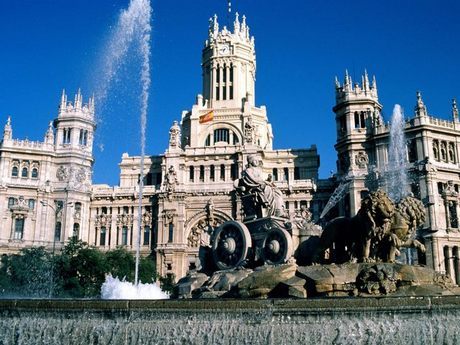Plaza de Cibeles
The Plaza de Cibeles is a square with a neo-classical complex of marble sculptures with fountains that has become an iconic symbol for the city of Madrid.
The monumental Cibeles Fountain has become a Madrid icon. Located in the heart of the city, it shows Cybele, the Greek goddess of fertility and nature holding a sceptre and a key while being pulled by two lions on a chariot. The pull of the wild lions symbolize the power of nature or of the goddess.
Up until the 19th century both the fountain of Neptune and Cibeles looked directly at each other, until the city council decided to turn them round to face towards the centre of the city.
Calle Alcalá is the street which intersects the fountain from east to west. Calle Alcalá starts in the Puerta del Sol and continues on to the beautiful Puerta de Alcalá. On the corners of the plaza de Cibeles ‘square’ you will find the headquarters of the Spanish Royal mail, housed in a stunning building which some people compare to a wedding cake. On another corner you will find the Bank of Spain and opposite it the military barracks. On the other side of the plaza, on the East side you will see the Palace of Linares.
The fountain of Cibeles is found in the part of Madrid commonly called the Paseo de Recoletos. This fountain, named after Cybele (or Ceres), Roman goddess of nature, is seen as one of Madrid's most important symbols. The Cibeles fountain depicts the goddess, sitting on a chariot pulled by two lions. The fountain was built in the reign of Charles III and designed by Ventura Rodríguez between 1777 and 1782. The goddess and chariot are the work of Francisco Gutiérrez and the lions by Roberto Michel. The fountain originally stood next to the Buenavista Palace, and was moved to its present location in the middle of the square in the late 19th century. Up until the 19th century both the fountain of Neptune and Cibeles looked directly at each other, until the city council decided to turn them round to face towards the centre of the city.
On one side of the fountain of Cibeles, the Paseo de Recoletos starts, heading north to link up with the Paseo de la Castellana. On the other side, the Paseo del Prado begins and heads off south, towards the fountain of Neptune, in the Plaza de Cánovas del Castillo, and on until Atocha. Calle de Alcalá is the street which intersects the fountain from east to west. Calle de Alcalá starts in the Puerta del Sol and continues on to the outskirs of Madrid.
The Spanish football (soccer) team Real Madrid has unofficially adopted the fountain. It is used as a meeting point for its fans and often for the players themselves whenever the team wins the Spanish league or Spanish Cup.
On each of the 4 corners of the square you may find an interesting building. The Palacio de Buenavista was constructed in 1777 and currently houses the Spanish Army's headquarters; the Palacio de Linares was constructed in 1877 and is owned by the Casa de América organisation, dependent on the Foreign Ministry and which promotes political, economical and cultural ties with Latin America.
The south-west corner of the square is home to the Bank of Spain, housed in a large, dignified building whose construction work started in 1884. Opposite the Banco de España is the Palacio de Linares. The baroque palace was built in 1873 by a rich banker, José de Murga. A century later, the building had fallen into disrepair but in 1992 it was completely renovated. It currently houses the Casa de América, a cultural center and art gallery focused mostly on Latin American arts. The building is said to be haunted by the spirits of its first owner, who made his fortune in the new world.
The most prominent of the buildings at the Plaza de Cibeles is the Palacio de Comunicaciones or Communications Palace. The cathedral-like landmark was built in 1909 by Antonio Palacios as the headquarters of the postal service. This impressive building was home to the Postal and Telegraphic Museum until 2007 when the landmark building became Madrid's official city hall (Ayuntamiento de Madrid). You can get there via flight to Madrid.




